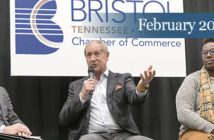Photo above: Virginia is divided into nine regions, with 13 Southwest Virginia counties designated as Region 1. Source: U.S. Census, VA PDC
By Scott Robertson
Southwest Virginia’s economic woes are undeniable, yet the region is not so much worse off than the rest of the Commonwealth in some respects. That fact has spawned the creation of an effort formally known as “Go Virginia, the Virginia Initiative for Growth and Opportunity in Each Region.”
Go Virginia, as it is commonly known, is designed to combat the decline in the state’s economy as measured by the Gross State Product (GSP, the statewide equivalent of the U.S. Gross National Product). Just as the declines in coal production and sales have hurt Southwest Virginia, so too has the decline in federal government spending hurt regions including Hampton Roads, Norfolk and Metropolitan D.C.
According to George Mason University figures, between 2003 and 2015, Virginia lost roughly 31,500 military jobs. From 2011 through 2015, the state lost almost 20 percent of its federal procurement outlays, from just over $60 billion to just over $48 billion. And even though the recovery from the Great Recession of 2008 has created more than 42,000 jobs in Virginia, the GSP has declined $6,316,720,900 in the same period.
When state government leaders asked why they were failing to replace high-paying jobs, the first answer was that the existing economic development structure did not give prospective employers what they wanted. The region, not the city or county, is the organizing unit of the 21st century economy, and the state lacked a purposeful approach to growing regional economies.
The opportunities to grow small to mid-size companies and to encourage development of industry clusters instead of piecemeal, one-company-at-a-time, hit-or-miss efforts all hinge on regional efforts. Yet government and tax structures in Virginia have promoted city-versus-city and county-versus-county competition instead of regional collaboration. As government and mining jobs left, the high-paying replacement jobs were going to states that had their regional acts together.
So, more than a year ago, private sector leaders began the process of creating a new way to distribute economic development funds in a way that would maximize the potential for success in several key areas including support for entrepreneurship; existing sector job growth, retention and expansion; workforce development; and enhancement of existing economic development efforts – all on a regional level.
That process has yielded Go Virginia, which has a budget of $5.5 million state dollars for fiscal 2017 and another $30 million for FY 2018. This year’s budget is designated for the development of each region’s economic growth and diversification plans.
Go Virginia has a statewide board comprised of 23 business and government leaders, each of whom is active in creating regional councils. The Commonwealth is divided into nine regions, with Southwest Virginia designated Region 1. The state board members representing Region 1 are Delegate Terry Kilgore and K-VA-T Food Stores President and CEO Steve Smith.
“Go Virginia encourages regionalism,” Smith said, “that’s one of the things this fund was set up to do, not only to encourage, but almost mandate that we have regional efforts to attract, promote and retain businesses. That’s exciting because we really are one region, and while I don’t know where the state line is between Tennessee is and Virginia for my business and don’t care, sometimes people do get a bit parochial. We should look at Southwest Virginia as one and realize that what’s good for one county will be good for others. Hopefully we’ll see people working together in a spirit of cooperation.”
In October, Kilgore and Smith met with Mike Quillen, a retired coal executive and Delegate Israel O’Quinn to begin formulating a list of potential regional council members for Region 1. “We discussed what kind of structure we wanted to use in the Southwest Virginia region,” Smith said, noting that the regional council would need to be able to create a growth and diversification plan based on the strengths of the region.
“We are looking for a combination of business professionals, folks who are job creators themselves; folks who work for the various planning districts we want to bring on; and some education professionals we hope to be able to bring on,” Smith said. “We’re going to put that team together over the next two weeks* and really have what we think will be a cross-functional group that will be able to put together some collaborative ideas on how to bring new industry into our region.”
Go Virginia officials are already working to fight the perception that the effort is just adding another layer to existing bureaucracies. Dubby Wynne, state board chair, said in October, “Go Virginia respects local government authority; it employs incentives, not mandates. We are not proposing new taxes or changes to existing tax streams. We are not proposing altering local control over schools, land use or any other government function. This is a private-sector-focused market-driven initiative, not bigger government.”
Regions will compete for Go Virginia Growth and Opportunity Grant dollars, with the state board providing policy and program direction and guidance on best practices. State board members will serve as ex officio members of their respective regional board. Some guidance has already been put in place, even before establishment of the regional boards. For instance, Go Virginia Growth and Opportunity grants will not be awarded to projects including:
• Construction of transportation projects (except as ancillary to site development)
• Incentive grants to private companies
• Economic development marketing
• Trade missions
• Quality of life projects.
Those projects will be left to the existing economic development entities. Growth and Opportunity Grant-eligible projects include:
• Scale-ups of existing small and medium-sized businesses (REAP – Regional Export Assistance Program)
• Credentialing and business focused training and curriculum development
• Site development
• Commercialization of R&D (public and private)
• Bioscience/neuroscience cross-regional collaborations
• Startup collaborations (incubators/accelerators)
Each regional council will submit to the state board potential projects for funding in its region that will enhance private sector growth and opportunity, economic competitiveness, and alignment of workforce development programs with the needs of employers in the region.
Once a regional council has submitted projects for funding the board will consider several factors including:
• Expected economic impact
• Fiscal resources committed to the project
• The number and percentage of localities participating in the region
• Expected impact and outcomes of projects as well as the complexity of projects
• Any projected cost savings
• Regional effort
• Interstate or inter-regional collaboration
• Efficiency of administration and oversight
• Compatibility of proposed projects with other projects, programs and existing infrastructure
When the board does decide to offer Growth and Opportunity grant support to a region, that support will be limited in duration and every grant will require the region to bring matching funds to the table. That requirement, Smith said, will be a point in Region 1’s favor. “I think we have a unique opportunity in Southwest Virginia we have the VCEDA funds that could be available along with some of the tobacco funds. We have some good leads, some good opportunities to piggyback some of those funds together.
“We may be in one of the best positions of any part of the Commonwealth,” Smith said, “and certainly we have as much need as any part of the Commonwealth from the coalfields down through the Virginia highlands.”
The next state board meeting is slated for March 14 in Richmond.
* The first two weeks of 2017





